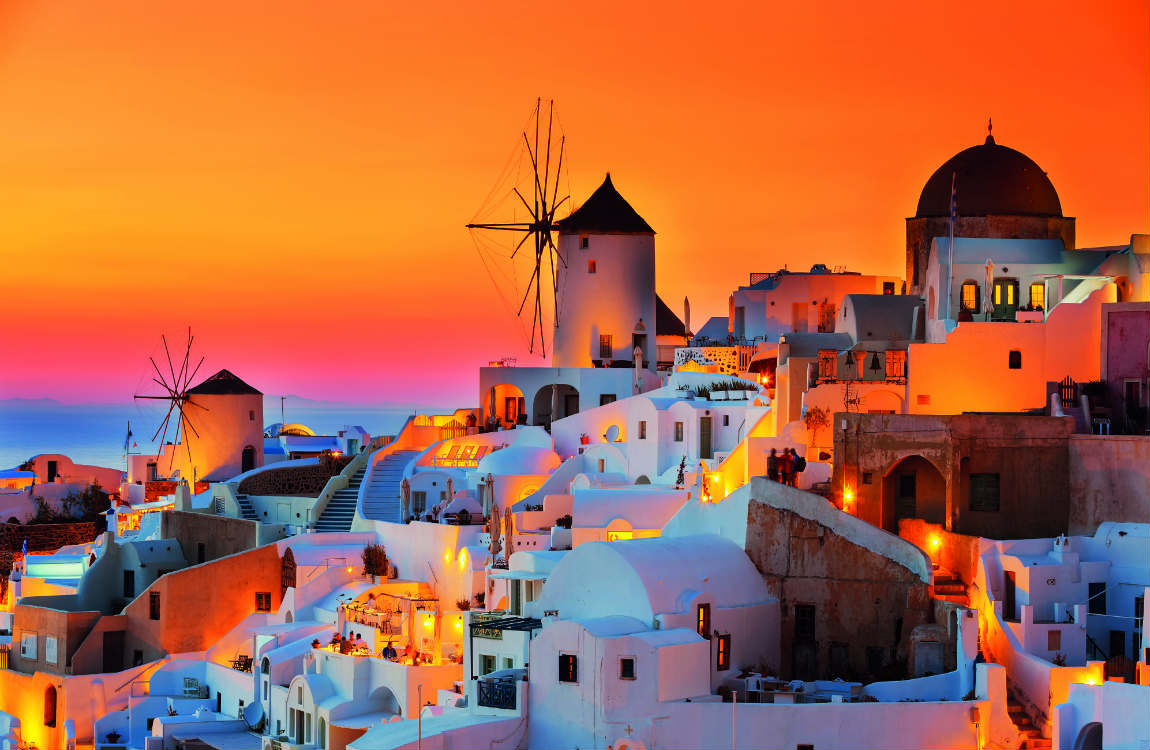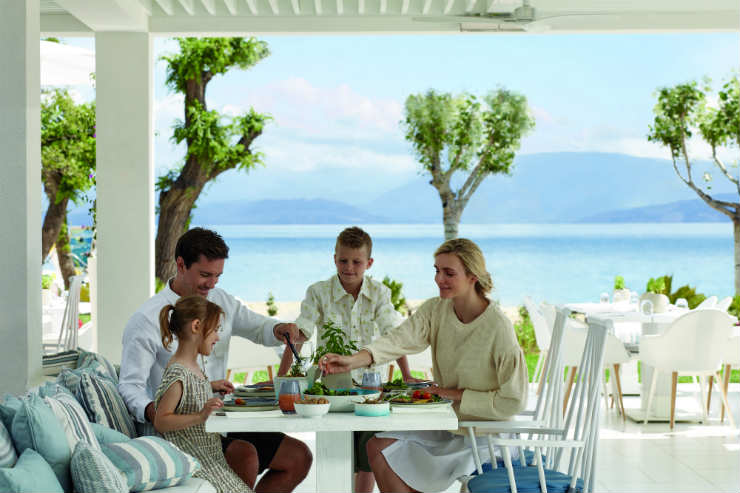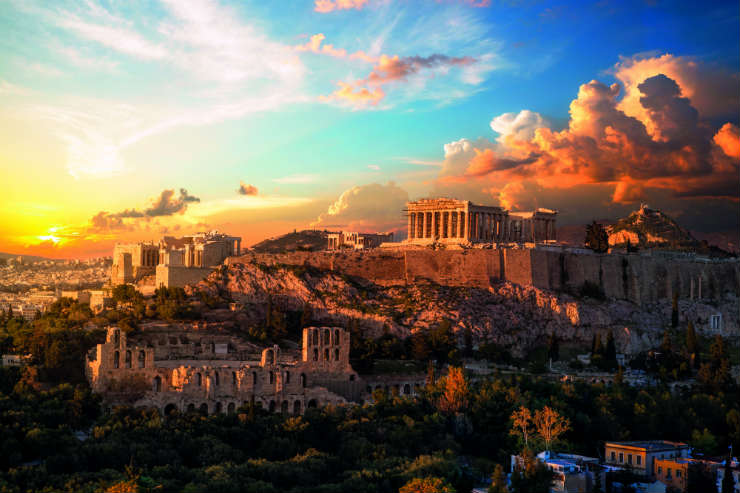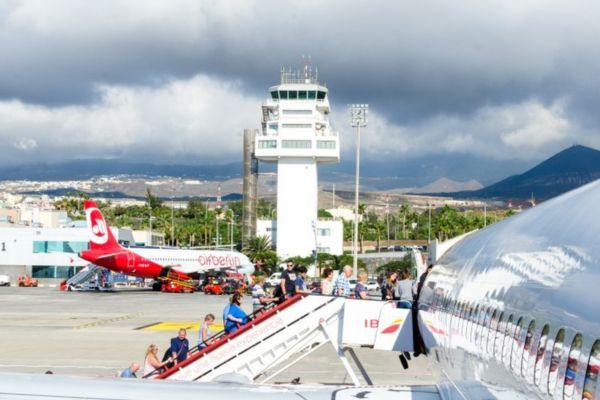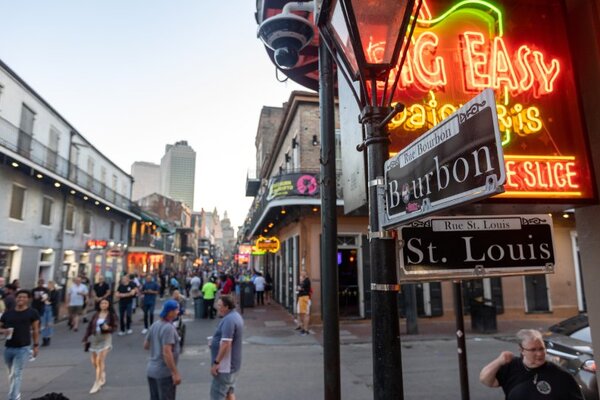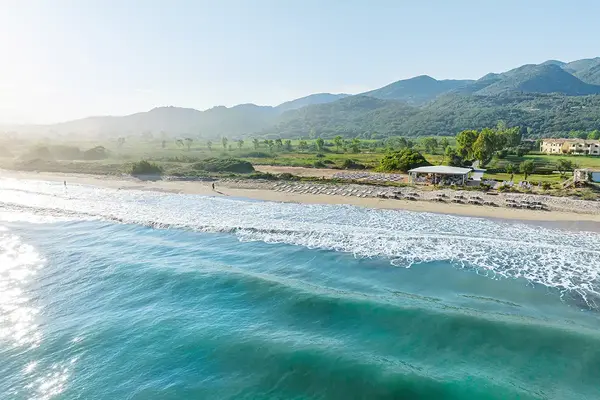An island-hopping trip around the Cyclades
Photogenic beaches, mouthwatering local dishes and quaint villages vie for attention on an island-hopping trip of the Cyclades islands

A sea of people have taken to their feet. Arms are extended, clutching camera phones, fingers hovering over the shutter buttons of cameras. A ripple of applause erupts and whistles of praise pierce the air. Here in the coastal town of Oia, Santorini, this standing ovation occurs nightly. The crowds gather in this same spot, strung between the tangle of narrow, winding flagstone streets for Greece’s greatest spectator sport – sunset-watching. And Oia is arguably the nation’s epicentre.
In 2018 this island of 16,000 inhabitants received more than two million visitors, not including cruise passengers, which accounted for up to 18,000 extra visitors a day. In a bid to combat overtourism, Santorini’s daily cruise ship arrivals have been capped at 8,000 since January, and numerous desalination plants have been set up to ease pressure on the island’s scarce water supply.
It’s easy to assume the influx has left the island’s residents feeling jaded, but this is
far from the truth. Rather than locals wearied
by tourists, we are met with a warm welcome and the kindheartedness for which Greece has long been renowned. From the kerasma (treat) that appears unsolicited at the end of every meal, on the house, to the hotel manager who insists on giving us a bottle of local wine to make up for our having to change rooms, everyone wants to brighten our day.
On my trip to Santorini, mornings are spent exploring tiny hilltop villages. Come afternoon we lounge on black-sand beaches and hop between the island’s many wineries. Evenings are made for watching sunsets and gorging on homemade food: creamy, tangy tzatziki mopped up with warm pitta, rounds of crisp, juicy, deep-fried domatokeftedes (tomato fritters, a local speciality) and fresh, colourful salads strewn with aromatic oregano and olives.
ISLAND EXPLORATION
This volcanic island might be Greece’s most well-known, but that doesn’t mean it’s the best, and a few nights is more than enough to explore what it has to offer. The Cyclades boasts 220 islands
and each has its own distinguishable assets.
Some older clients might dismiss the idea of island-hopping as a backpacker’s pursuit, but
this quintessential Greek travelling experience is accessible to almost everyone, with modern ferries plying the Aegean regularly. Operators such as Sunvil will happily package up a multi-island break with all boat and ground transfers, so there’s fewer unknowns for your client to fret over.
Dudley der Parthog, Greece director for the operator, explains the Cyclades’ appeal with tips for agents selling them. “The Cyclades are perfect for the classic Greek island-hopping holiday as ferry links have improved hugely in recent years. There are many [islands] to choose from, ranging from lively and buzzing to traditional and quiet. As a general rule, the more difficult an island is to reach, the quieter it is. We recommend Santorini and Mykonos as good jumping-off points for lesser-known and less-crowded islands.”
Ensure clients are aware that the Cyclades Islands are a pricier Greek choice, he adds. “A holiday here is generally more expensive than a one- or two-week package to other island groups or the mainland. This is due to their popularity, combined with smaller accommodation units and higher transportation costs.”
A rustic alternative
HOW TO AVOID THE SANTORINI SQUEEZE
Non-peak blinders: Encourage your clients to travel outside of peak season. July was by far the most popular month in 2018, with numbers reaching almost four million, and August wasn’t far behind. The shoulder seasons of late spring and early autumn (May to mid-June and September to mid-October respectively) boast the twin pulls of lower prices and fewer crowds. Travelling during this time also means your clients are more likely to avoid the full force of the meltemi – the strong summer winds that can lead to ferry delays and boat tour cancellations, and also render beach time uncomfortable.
What a capital idea: Though the views are iconic and its streets idyllic, it’s best to avoid staying in Oia, which is largely overpriced and overrun with tourists. Its location at the northwestern tip of the island also means it takes a long time to get anywhere else. Capital Fira is a worthy alternative. Situated at the heart of the island, it’s Santorini’s transport hub and offers plenty of amenities – plus the sunset here, over the caldera, is also stunning.
From Santorini, it’s just a two-and-a-half hour ferry ride to Milos, one of the Cyclades’ lesser- known isles. Said to have more beaches than any other Cycladic island, Milos makes for an ideal counterweight to Santorini that, with its black and red volcanic sands, isn’t known for its shoreline. The beaches on Milos range from idyllic sandy shores at Provatas to the technicolour cliffs of Paleochori, coloured by geothermal activity. Milos has also yet to hit superstar tourism status, providing light relief for clients who have reached saturation point with Santorini’s crowds and hype. In Milos, quaint fishing villages freckle bays; rustic tavernas line the shore, offering views of the azure, crystalline waters; and clients can explore eerie ancient catacombs with few other visitors.
It takes less than two hours to reach Paros
from Milos on the fast ferry, but it feels a world away. Unlike Santorini and Milos, Paros is
not part of the South Aegean Volcanic Arc, meaning its landscape and geology is drastically different. The most northerly of the three, Paros is a hilly, green isle where agriculture was once king. Today, the island is still awash with smallholdings – a patchwork of fields of wheat and barley, olive groves and orchards full of citrus trees – though tourism is slowly taking over as the industry of choice. It makes for a fantastic place to hire a car and get lost in the interior.
Paros is perhaps most popular with families and watersports enthusiasts, thanks to its plentiful long, sandy beaches and its famously windy eastern shoreline offering perfect conditions for kite and windsurfers.
Skipping between Santorini’s dramatic landscapes, Milos’s picture-postcard beaches and Paros’s rolling green hinterland proves an adventure that’s more than worthy of applause.
BOOK IT: Sunvil offers a 10-night multi-island trip from £1,253pp based on two sharing including three nights’ B&B at Contaratos Beach Hotel
in Paros, four nights’ self-catering at Vourakis Studios in Milos and three nights’ B&B at Sunrise Hotel Fira in Santorini. Price includes flights and boat and ground transfers. Valid for 8 May 2020 departure.
Smarter, better, fairer
Smarter: A car is invaluable for getting off the beaten path on the islands, allowing clients to access smaller, local restaurants for a more authentic experience.
Better: Recommend a boat trip to see the islands from a different perspective. Local operators offer trips on almost every island, providing access to otherwise unreachable bays, often including lunch onboard.
Fairer: Suggest avoiding donkey rides; these animals are often treated poorly, with little access to shade or water and are burdened with excessive loads. Avoiding hotels with pools is also important in Santorini: the weight is causing cliffside erosion and sagging.
